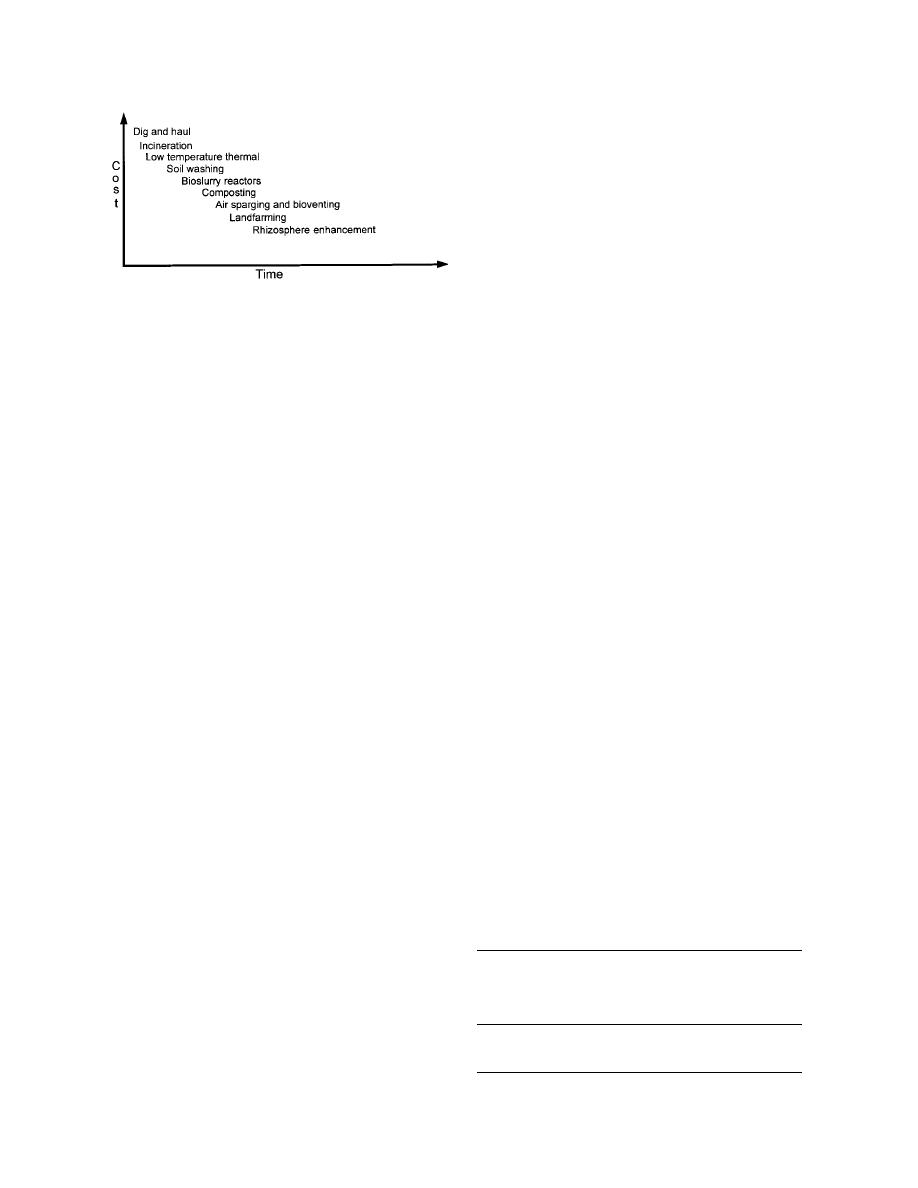
High Input
Low Input
known about degradation of heavy-fuel-contami-
nated soils as compared to diesel-fuel contamina-
tion, we expected that a double comparison would
provide a better context for analyzing the differ-
ent techniques.
Project location and soil history
This CPAR project was conducted at the Farm-
Freezethaw stimulated activity
Natural attenuation
ers Loop Permafrost Research Facility in
Fairbanks, Alaska. For each biotreatment system
Figure 1. Relative inputs and treatment times for
(landfarming and ex-situ pilebioventing), two
remediation technologies.
soils were used. One soil was from a gravel pad
area near pump station number 10 on the trans-
Alaska pipeline. This soil was contaminated with
heavy oil. The other was a sandy soil contaminated
respond to biotreatment. Landfarming can be a
with diesel. This material had been used as tank
successful treatment option in cold regions
bedding and backfill for a fuel storage tank at Ft.
(Reynolds 1993a,b; Reynolds et al. 1994).
Wainwright, Alaska, and was excavated during
Bioventing of stockpiled, diesel-contaminated soil
tank replacement. These two soils are typical of
has also been used in northern climates, but owing
many contaminated soil sites in northern regions.
to low temperatures and the distance of many sites
from readily accessible highways, logistical, con-
struction, and maintenance requirements and costs
FIELD REMEDIATION PROCEDURES
are greater than in more temperate climates.
Studies have shown that stimulating soil mi-
For each contaminated soil, we compared the
crobial activity in diesel-contaminated soils in
effects of landfarming to those of bioventing.
biopiles may raise soil temperatures by 13C (Brar
For all soil-contaminant and treatment scenarios,
et al. 1993). Also, nutrient amendments to diesel-
we also tested the effects of nutrient additions
contaminated soil can enhance bioremediation
(Table 1).
rates in both landfarming and bioventing
To comply with regulatory guidelines that were
(Reynolds 1993b, Brar et al. 1993, Walworth and
in effect at the start of the field work, treatments
Reynolds 1995).
were conducted in plots that were lined and
Biotreatment of soils contaminated with heavier
bermed. For the landfarming plots, the cells were
oils, such as no. 6 heating oil, bunker C fuel oil,
approximately 3 m square and 60 cm deep. The
and crude oil, have not been evaluated to the same
bioventing plots were approximately 1.5 by 3 m
degree as diesel-fuel-contaminated soil. And, be-
by 100 cm deep. These configurations are repre-
cause a greater proportion of heavy fuels is com-
sentative of both landfarming and bioventing pro-
posed of recalcitrant compounds that have lim-
cedures for small-scale spills. Landfarming usu-
ited water solubility, these contaminants are less
ally distributes soil in a relatively thin layer that
readily bioremediated than diesel fuel.
requires a greater area than bioventing, which
can use deeper layers of soil.
Objective
The objective of this project was to demonstrate,
evaluate, and increase the knowledge base on us-
Table 1. Demonstration factors.
ing cost-effective, on-site bioremediation tech-
niques for treating heavy-oil-contaminated soil in
Factor
Levels
Description
seasonally cold regions.
Contaminant
2
Heavy-oil, diesel
Approach
Treatments
2
Landfarm, bioventing
The research plan was to compare landfarming
Subfactors
Levels
Description
and bioventing as treatment technologies for
heavy-fuel- and diesel-contaminated soils in cold
Landfarm
2
Control, plus nutrients
regions. This was done by conducting side by side
Bioventing
2
Control, plus nutrients
comparisons in the field. Because so much less is
2



 Previous Page
Previous Page
